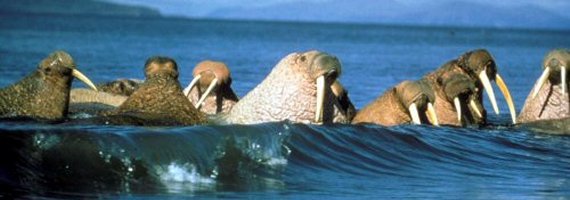Watchable Wildlife

Think of your favorite photo of an Alaska Brown (grizzly) Bear and most likely it was taken at Katmai National Park or McNeil River State Game Sanctuary. This region is world famous for unsurpassed bear viewing and photographic opportunities. Even the novice photographer can take home snapshots that will astound friends and neighbors. Approximately 10,000 bears populate the region, making them more numerous than people. These famous bruins may be encountered anywhere in the Bristol Bay area. Many outfitters offer excursions to areas where you can see bears in a true wilderness setting. McNeil River limits the number of visitors per day. Katmai does not limit visitation, but lodging, camp sites and transportation may be difficult to obtain during periods of peak bear viewing. Because of the popularity of Brooks Camp in Katmai National Park and the McNeil River area, be sure to plan ahead.
While bears may be the most famous residents of the area, they are not the only mammals that are found passing through Bristol Bay and the Alaska Peninsula. Both the Mulchatna and Peninsula Caribou herds can be found passing through the region. The Mulchatna herd is estimated at nearly 200,000 animals. Seeing these animals in large congregations during calving season is an experience that you won’t forget. The majestic moose may be found in many tundra ponds and wetlands. Red fox, beaver, porcupine, river otters, artic hares and wolves are also common in the region. Keep your camera ready.Common Sense in Bear Country
- In most cases, bears are not a threat, but they do deserve your respect and attention.
- When traveling in bear country, keep alert and enjoy the opportunity to see these magnificent animals in their natural habitat.
- Avoid surprising bears; look for signs of bears and make plenty of noise.
- Avoid crowding bears; respect their personal space.
- Avoid attracting bears through improper handling of food or garbage.
- Plan ahead, stay calm, identify yourself, don’t run.
Birds
Birding in Bristol Bay offers the adventurer five different ecosystems: marine, river, tundra, boreal forest, and lake. Spring and fall migrations include numerous shore birds such as plovers, sandpipers, godwits, and redknots, just to name a few. The spring swan migration is truly spectacular as thousands of these majestic waterfowl move through the area. While walking through the boreal forest you might hear the chatter of the Boreal Chickadee, the chime of the Varied Thrush or the song of the Lincoln Sparrow.
Interested birders could spend several days seeking out any of the 157 species of birds that nest here or pass through to nest farther north.
Marine Mamals
Mention marine mammals in Bristol Bay and the first one that comes to mind is the beluga whale. Belugas are a relatively small, beautiful white whale. An adult beluga is ten to fifteen feet long and weighs up to 3,300 pounds. As many as 3,000 beluga live in the waters of Bristol Bay. The best time to view these magnificent creatures is late April through the month of May. Belugas may also be found in the rivers in the late summer and fall when the silver salmon are running (August and September). They normally swim into the rivers on the incoming tides and leave the rivers on the tide ebbs.
Other marine mammals such as sea otters, sea lions, harbor seals, orcas (killer whales) and migrating gray whales may also be seen inhabiting the shoreline and offshore waters. Iliamna Lake supports one of only two colonies of freshwater seals in the world.
- Observe animals from a distance, watching for changes in their behavior that indicate distress.
- Avoid sudden movements or surprise encounters at close range.
- Use binoculars for closer observation and long-range telephoto lenses for close-up photographs.
- Never chase or disturb animals to “create an action shot” for your camera.
- Respect nests, dens, rookeries and haul outs. Alarm cries and displays are an animal’s warning for you to keep your distance.
- Avoid coming between or disturbing female animals and their young.
- Don‘t handle or adopt “orphan” animals, parents are usually nearby.
- Don’t feed wild animals. Feeding wild animals is against Alaska State law.
- Carry out all trash. Wildlife can be endangered by discarded plastic or other garbage.
- Pets can make it difficult to view wildlife. It’s best not to bring them.
- Be considerate of other viewers.
- Use existing roads and trails. Minimize your impact on wildlife habitat.
- Report wildlife or environmental abuse.
Source: Bristol Bay Visitor Guide
For more information download the full printable Visitor Guide and Business Directory
